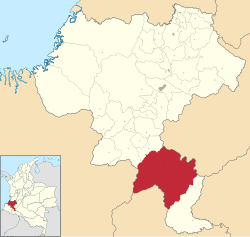
Cartago is a city in southwestern Colombia, about 187 miles (301 km) west of Bogotá. It is in the extreme northern portion of the Valle del Cauca. It is located very close to the city of Pereira, Risaralda about a 20-minute drive. It is the sixth largest city in Valle after Cali, Palmira, Buenaventura, Tuluá and Jamundí. Per the 2018 Colombian census, Cartago's population was 142,902.
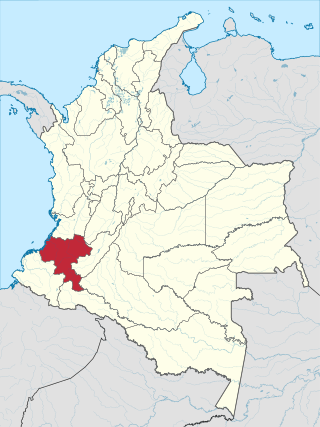
Cauca Department is a Department of Southwestern Colombia. Located in the southwestern part of the country, facing the Pacific Ocean to the west, the Valle del Cauca Department to the north, Tolima Department to the northeast, Huila Department to the east, and Nariño Department to the south. Putumayo and Caqueta Departments border the southeast portion of Cauca Department as well. It covers a total area of 29,308 km2 (11,316 sq mi), the 13th largest in Colombia. Its capital is the city of Popayán. The offshore island of Malpelo belongs to the department. It is located in the southwest of the country, mainly in the Andean and Pacific regions plus a tiny part (Piamonte) in the Amazonian region. The area makes up 2.56% of the country.

The Cauca guan is a bird in the chachalaca, guan and curassow family, Cracidae. It is a large guan, and like most guans leads a mostly arboreal life in humid forests, where it forages for fruit and leaves. The Cauca guan is endemic to Colombia's Cauca River valley.

Piamonte is a town and municipality in the Cauca Department, Colombia.

Rafael Reyes Prieto was a Colombian politician and soldier who was the Chief of Staff of the Colombian National Army and President of Colombia (1904–1909).

The Colombian Massif, also known colloquially as Nudo de Almaguer, refers to a group of mountains within the Andes of south central Colombia. The massif is mainly within the area of the Cauca, Huila, and Nariño Departments. To the south is the Pasto Massif and to the north begins the Central and Eastern Andes.

Santa Rosa is a Colombian municipality located in the department of Cauca, in the region known as the Bota Caucana. It is located on the eastern slope of the Colombian Massif, the mountainous area where the Central and Oriental Cordilleras merge. Its economy is based on agriculture, its main products are corn, sugar cane, plantain and livestock. It includes the corregiments of Carmelo, San Juan de Villalobos and Descanse.

Colombian Spanish is a grouping of the varieties of Spanish spoken in Colombia. The term is of more geographical than linguistic relevance, since the dialects spoken in the various regions of Colombia are quite diverse. The speech of the northern coastal area tends to exhibit phonological innovations typical of Caribbean Spanish, while highland varieties have been historically more conservative. The Caro and Cuervo Institute in Bogotá is the main institution in Colombia to promote the scholarly study of the language and literature of both Colombia and the rest of Spanish America. The educated speech of Bogotá, a generally conservative variety of Spanish, has high popular prestige among Spanish-speakers throughout the Americas.

El Abra is the name given to an extensive archeological site, located in the valley of the same name. El Abra is situated in the east of the municipality Zipaquirá extending to the westernmost part of Tocancipá in the department of Cundinamarca, Colombia. The several hundred metres long series of rock shelters is in the north of the Bogotá savanna on the Altiplano Cundiboyacense, Eastern Ranges of the Colombian Andes at an altitude of 2,570 metres (8,430 ft). The rock shelter and cave system is one of the first evidences of human settlement in the Americas, dated at 12,400 ± 160 years BP. The site was used by the hunter-gatherers of the Late Pleistocene epoch.
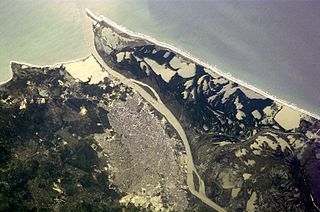
Immigration to Colombia during the early 19th and late 20th Century, is what makes it one of the most diverse countries in the world, above other countries in the Latin region. Colombia inherited from the Spanish Empire harsh rules against immigration, first in the Viceroyalty of New Granada and later in the Colombian Republic. The Constituent Assembly of Colombia and the subsequent reforms to the national constitution were much more open to the immigrants and the economic aperture. However naturalization of foreigners, with the exception of those children of Colombians born abroad, it is still difficult to acquire due 'Jus soli' law is not allowed by the government, and only 'Jus sanguinis' law is accepted. Immigration in Colombia is managed by the "Migración Colombia" agency.

El Morro del Tulcán is an Indigenous pyramid in Popayán, Colombia.
Guillermo Abadía Morales was a Colombian linguist, academic, anthropologist, folklore researcher and indigenous language expert. Abadía Morales was one of the first to champion the study of indigenous languages in Colombia.

The Colombian Institute of Anthropology and History, ICANH, is a scientific and technical government agency ascribed to the Ministry of Culture in charge of researching, producing and disseminating knowledge in the fields of anthropology, archeology and colonial history to protect the archaeological and ethnographic patrimony of Colombia.

Celso Piña Arvizu was a Mexican singer, composer and accordionist, mainly in the genre of cumbia, being one of the most important musicians in the style of "cumbia rebajada".

Miguel Triana Ruiz de Cote was a Colombian engineer and Muisca scholar. He is best known for his 1922 publication La Civilización Chibcha; "The Muisca civilisation". Triana wrote a number of books about the Muisca and their culture. Miguel Triana especially contributed to the knowledge of the religion, society and the creation of rock art throughout the Muisca Confederation. Triana was the first Colombian investigator relating the Muisca culture with the pictographs. He described hundreds of rock paintings and carvings in his book El jeroglífico Chibcha.
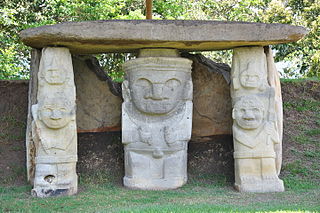
Juan Friede Alter was a Ukrainian-Colombian historian of Jewish descent who is recognised as one of the most important writers about Colombian history, the Spanish conquests and a proponent of indigenism; the defense of the rights and descriptions of the oppression of indigenous people.
Fernando Etayo Serna is a Colombian paleontologist and geologist. His contributions on the paleontology in Colombia has been mainly on the descriptions of ammonites and Etayo has helped describing many fossiliferous geologic formations of Colombia. Etayo obtained his MSc. degree in geology and geophysics from the Universidad Nacional de Colombia in 1963, and his PhD in paleontology from the University of California, Berkeley in 1975.
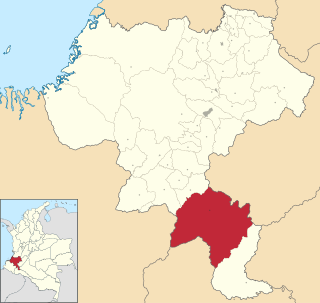
San Juan de Villalobos is a corregiment in the south of the department of Cauca in the region known as Media Bota Caucana, municipality of Santa Rosa. The town was settled in 1937 along National Route 45 at a distance of 8 km from the border between the departments of Huila and Cauca. This town is an obligatory passage between Pitalito and Mocoa and has gained relevance after the construction of National Route 45.
